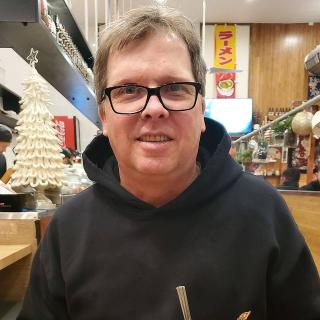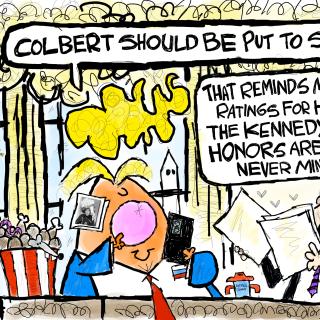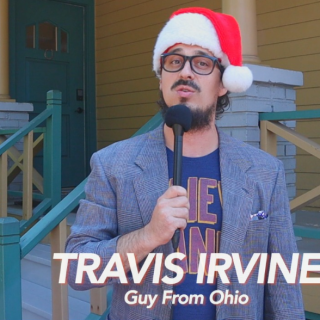Advertisement
A few days before Christmas, having quit his job in Germany, Matthias (Marin Grigore) returns to his multi-ethnic Transylvanian village. He wishes to involve himself more in the education of his son, Rudi (Mark Edward Blenyesi), left for too long in the care of his mother, Ana (Macrina Barladeanu), and to rid the boy of the unresolved fears that have taken hold of him. He’s preoccupied with his old father, Otto (Andrei Finti), and also eager to see his ex-lover, Csilla Szabo (Judith State). When a few new workers are hired at the small factory that Csilla manages, the peace of the community is disturbed, underlying fears grip the adults, and frustrations, conflicts and passions erupt through the thin veneer of apparent understanding and calm.
We recall watching a Mel Brooks film in the eighties called "Young Frankenstein." It was already a comedy, but even more for us, since the main character was getting on board a train in New York and getting off that train in Bucharest, which in the film was Transylvania’s capital. Transylvania stands for that place which is at the end of the world and is also the country of vampires and monsters. The story of "R.M.N." takes place a little before the pandemic, during Christmas 2019 and the beginning of 2020, in a small multi-ethnic village in Transylvania, the most western Romanian province. We go deep into Transylvania’s history but for us, it represents the typical kind of territory that was disputed between two countries and passed from one to another. A bit like Alsace and Lorraine.
In this case it’s between Romania and Hungary, or rather the Austro-Hungarian Empire. Therefore, there are Romanians and Hungarians living in Transylvania. But they’re not the only inhabitants. Some 700 years ago Saxons were given land there, at the edge of Europe, next to the Carpathians. Therefore, there are also Germans in Transylvania. Most of them left in the 70s when Ceausescu sold them to Western Germany for 5,000 DM per capita. The rest left after the fall of communism. But their houses, fortified churches, cemeteries, and villages with tall fences are still there. And there are also many Roma people in Transylvania.
They first came as slaves or servants some 200 years ago, and many moved into the houses abandoned when the Germans left. With so many ethnicities, Transylvania became a favorite playground for populist or nationalist movements of all kinds. There were street fights with victims in the 90s. Later things calmed down and many people went to work abroad as poverty affected them regardless of ethnicity. Nationalism is refreshed again every now and then, especially before elections.
The film is about the situation in Transylvania and about Romanians, Hungarians and Germans sharing the same territory. It's set there, but it’s also about Russians and Ukrainians, whites and blacks, Sunni and Shia, rich and poor, even tall and short. Whenever there’s a second person in the room, they will be perceived as being from another tribe and therefore a potential enemy. Languages, religions, flags (and other minor differences for which people kill one another).
In the film, Hungarians speak Hungarian, Romanians, Romanian, and Germans speak German, but nevertheless they understand each other. They all speak English since it’s also a story about globalization and its side effects. The most sophisticated characters even speak French. And, of course, the Frenchman speaks English, while the people who came from afar speak their own language which nobody else understands. As a spectator, if you understand all these languages, bravo.
If not, there are subtitles, sometimes they've different colors for different languages, sometimes it will be up to you to figure out who speaks what. The Romanians have a red-yellow-blue flag, the Hungarians in Hungary have a red-white-green flag, but the Hungarians in a couple of Transylvanian counties have a blue and yellow one, the flag of the so called Tinutul Secuiesc, which militates for autonomy. Strangely, for of historical reasons, this county is not on the border with Hungary but somehow in the middle of Romania. Romanians are mostly Orthodox; Hungarians are mostly Catholic while Germans are mostly Lutheran. But it’s not that simple: some Hungarians are Unitarians, some Romanians are Greek-Catholic, some Germans are Calvinist. Therefore, each village has several different churches, and even the bells toll differently.
Today, with so many people having gone abroad to work, many of the churches have very few parishioners. The Protestant churches are closed. Still, there's usually somebody in the village who holds the key to the church for whoever wishes to visit. When somebody from the village dies abroad, sometimes thousands of kilometers away, a relative of his will call home, so that the bells in his native village toll for him. These differences might seem minor, and they're certainly complicated to follow. Still, throughout history wars were fought because of such particularities and people killed other people for even smaller differences.
Mioritza is an inspiration for the film. Mioritza is tricky to explain, it’s a national Romanian ballad about three shepherds and their herds. Now these shepherds come from different regions, one has more sheep, and he’s richer, so the others simply decide to kill him and take over his herd. His beloved sheep, his faithful dog, and nature in general try to warn him, but he believes in destiny: if this is his fate, so be it. There’s even a pattern associated with Mioritza, with Romanian geography and with this mentality about life: it’s called the uphill and downhill rhythm. Matthias faithful dog warns him when danger arises and his sheep care for him maybe more than anybody else. Besides Mioritza, of course, there's the real story: before the pandemic some factory owners in Tinutul Secuiesc considered hiring workers from afar, given that the locals had left to work in Western Europe.
Still, the characters of R.M.N. and the relationships between them are fictional, as are the motivations and attitudes of each, and the events of the narrative itself. Another distant source of inspiration is the Rosia Montana story, essentially, it’s the dilemma between giving people jobs mining gold and destroying the environment with cyanide or saving the environment and wonderful landscapes for future generations while the locals live in a continued state of poverty. And then, there are the regular news stories about animals and the side effects of Romania apparently having the biggest population of bears and wolves in Europe.
Traditions mean that people do something because some other people did it before them. In the end, somebody did it originally for some purpose, which very often is to chase away bad omens. You must agree even this explanation has more sense than doing something because it’s the tradition. The film portrays several winter traditions: some people dress in sheep and goat skins and dance, others wear bear skins and are whipped, some dress as the ancestors, the Dacians, sympathized with for opposing the Roman conquest.
In some other areas in Romania, men simply wear masks and a huge helmet for the New Year’s Eve. They meet on the first day of the year, and they fight each other to death. They don’t even come from different villages: the uphill ones fight the downhill ones, and sometimes some get killed. Don’t judge them: at least it’s fair and square. Not very different from all the sports and competitions which substitute for the same instinct of engaging your tribe against another. One of the most recurrent narrative explaining Romania’s current position among European countries is that we didn’t manage to develop as much as western societies because we're busy fighting the invaders who wished to plunder Europe, and because we kept them busy here in the East, westerners had all the time in the world to develop, and erect their opulent cathedrals.
But there are a lot of other current narratives used to explain the state of the world today, globalization is the new Babel, a sign that the world is coming to an end; when diseases will also become global, the end will follow swiftly, global warming is yet another sign of the imminent ending and soon the over-exploited resources will be exhausted and people will be fighting for survival. For centuries, it's easier to identify the invaders. The locals live in small villages among the forests and as soon as anybody on horseback showed up from the other side of the hill, he was a potential enemy tourism came later.
Today, with airplanes, things got more complex. One peculiar stereotype regards the Huns, the Hungarians’ ancestors, arriving at horseback and eating the raw meat they tenderized under their saddles. The stereotype is so common that nobody doubts it. Some 30 years ago, The European Council recommended the use of the term Roma instead of Gypsy, perceived as offensive. Romania tried to oppose the initiative for the confusion it generated between Roma and Romanians but with no success, so the confusion deepened. For Romanians, to be taken as Roma is the greatest offense while westerners perceive our desire to make the distinction as already an inappropriate discriminatory attitude.
"R.M.N." brings into question the dilemmas of today’s society, solidarity vs. individualism, tolerance VS selfishness, political correctness VS sincerity. It also brings into question this atavistic need to belong, to identify with one’s ethnic group, with one’s tribe, and to naturally regard others, whether of another ethnic group, another religion, another gender, or another social class, with reservations and suspicion. It's a story about old times, perceived as trustworthy, and present times, perceived as chaotic, about the underhandedness and falsity of a European set of values that are claimed more than they're implemented.
It’s a story about intolerance and discrimination, about prejudice, stereotypes, authority, and freedom. It's a story about cowardice and courage, about the individual and the masses, about personal versus collective destiny. It's also a story about survival, about poverty, about fear and a grim future. The film speaks about the effects brought by globalization in a small community rooted in secular traditions, values of bygone times have dissipated, but the access people got now to the internet did not bring updated values but rather burdened them with the difficulty of distinguishing the truth and their personal opinions in today’s informational and moral chaos.
"R.M.N." also tackles the side effects of political correctness: people learned that it is better not to speak up if their opinions differ from the norm of the day, but the political correctness is not a formative process, and it didn’t change opinions profoundly, it just makes people express less what they think. But eventually things cumulate and at some point, they spill out. The story itself associates politically incorrect opinions with particular ethnicity or group, since opinions and actions are always individual, they're not dependent on any group identity but on much more complex factors.
Beyond social connotations, it speaks about how our beliefs can shape our choices, about our instincts, irrational urges, and fears, about the animals buried inside us, about the ambiguity of our feelings and actions and the impossibility of ever fully understanding them. There are several recurrent images and visual motifs in the film. If you ever have the patience to watch the film twice, you’ll have something more to discover. Shooting one take per scene no matter how long or complex the scene is, a statement that profoundly shapes the filmmaking style. You need to stage the situation as believable and as truthful as you can and then record this moment. The rhythm is not coming from editing, but it’s internalized. Ellipses take place only between scenes, the situation unfold in real time, nothing is cut off.
Opens
Fri, May 5, 3.45 pm
Sat, May 6, 6.00 pm
Sun, May 7, 1.45 pm
Wed, May 10, 5.00 pm
At Gateway Film Center








